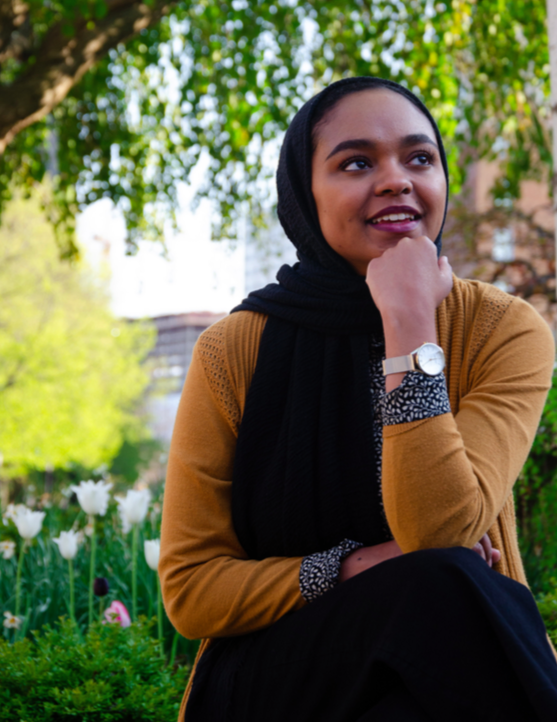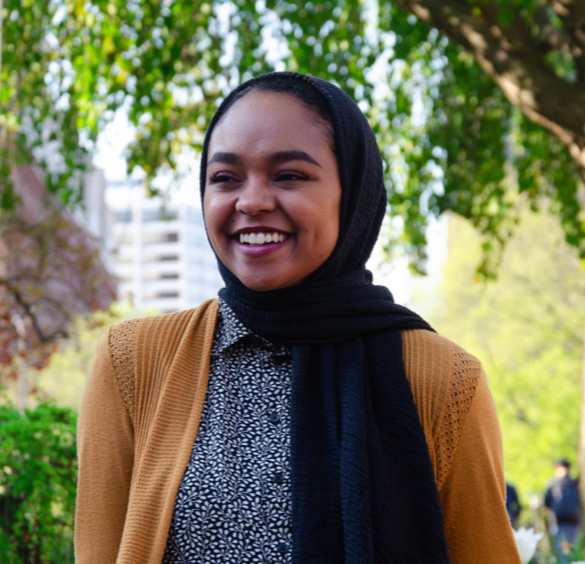For students who dress modestly, self-expression goes beyond a fashion trend.

One of first-year Rwan Ibrahim’s favorite outfits is a white T-shirt layered with a denim button-up, paired with striped yellow-and-white pants and white Birkenstock-style sandals. To bring the whole look together, she wears a breezy, mustard-colored hijab.
“[The Hijab] is not just a scarf on your hair,” Ibrahim, who is Muslim, says. “It’s not just the way you dress. It’s your connection to God, and it’s also your way of devoting yourself to your religion. But with that does come physical modesty. You also get to play around with it. You get to have your own sense of style, and I think that’s a beautiful part of it.”
Ibrahim considers herself a consumer of the growing modest fashion industry that’s spreading across college campuses, catwalks and the world. The Washington Post projected the modest fashion industry will be worth $373 billion by 2022. In 2017, Nike started selling performance hijabs and Project Runway featured its first modest fashion designer, Ayana Ife, as a competitor.
While the industry gains popular attention, young people like Ibrahim have honed their own modest styles of dress for years. Ibrahim has 20 scarves at Northwestern, and her family has collected over 60. When shopping, she chooses clothes that cover her chest, arms and legs. She loves to wear boots and pair a turtleneck with a turban, one of the many ways to wrap a headscarf.
It was Ibrahim’s personal decision to start wearing the hijab in her second year of high school. “It was always something that I was really empowered by, and I knew that it was another step in my religion that I could use to become more modest ... and have that connection with God,” she says.

Mónica Juarez is a Catholic third-year from the suburbs of Chicago. “When people just in general hear ‘modesty’ ... I think the reaction can sometimes be that we think our ankles or elbows are going to send us to hell, or something like that,” Juarez says. “And that’s obviously just so far from the truth.” She usually wears skirts no shorter than her knees and shorts that go to at least fingertip length, and she avoids low-cut necklines.
Juarez wore a Catholic school uniform from kindergarten through high school. While her modest dress today is inspired by the Church’s teachings, she is defining her own style and idea of modesty in college. “[When I was] younger, modesty to me meant those rules and guidelines,” she says. “As I’ve gotten older, it’s changed to have a much deeper meaning.” For Juarez, modesty is reflected in one’s thoughts, actions, words and dress. “I want my clothing to be able to show me as a whole person,” she says.
Hannah Cohen, a second-year who is a Modern Orthodox Jew, says that because her family didn’t instruct her on how to dress, she had the freedom to come to modesty on her own and feel more secure in it.
“[Modesty] is saying you should value what’s on the inside more than the outside,” Cohen says. “I think that message is really valuable, and it’s just the way it’s presented which can get skewed very easily.”
Cohen says that recent trends, like the popularity of loose-fitting pants rather than skinny jeans, have lent themselves well to dressing modestly. In general, most students interviewed say it is relatively easy to find clothing that meets their definitions of modesty, citing JCPenney, Kohl’s and H&M as stores they frequent.
However, some modest dressers are dissatisfied with the quality of fast-fashion brands, so much so that they have created their own. Adilah Muhammad, a Chicago-based modest fashion designer and owner of the ADILAH M apparel brand, almost exclusively wears clothes of her own design. “[It was] to the point where I was like, I’m not buying anybody else’s clothes,” she says.
Growing up in a Muslim household with a mostly Christian extended family and attending college in the South, Muhammad has seen what modesty means to people of different faiths and backgrounds. As a child, she only consciously dressed modestly when going to church or mosque, but she didn’t often wear short skirts or shorts day-to-day, either. She remembers thinking, “All the princesses in movies are wearing longer skirts. Those are cute, I want to look like that.”
It wasn’t until she studied fashion merchandising and design at North Carolina Agricultural and Technical State University that she became interested in modest fashion. Muhammad says that, by attending a historically Black university, she found a hub for conscious, purposeful fashion.
Before starting her own brand, she would receive pictures from women, both religious and not, of clothing they liked but wanted altered so that the neckline was higher, the skirt longer or the cut looser. Muhammad says celebrity styles that tend to be body-conforming may leave many women feeling vulnerable. “That’s cute and all, and it looks good on Beyoncé, but I’m not Beyoncé,” she says.
For Galit Rosenblatt, a Modern Orthodox Jewish second-year, dressing modestly can be tiring and feel like a lot of pressure. “Sometimes I’m the only religious Jew a lot of people know. And so sometimes I feel like I’m the face of those people ... like I have a standard to uphold,” she says.
Ibrahim also feels like she has a duty to represent hijabis and Muslims, but she says it challenges her to be the best version of herself. “I think it can be really easy to be really pessimistic about the fact that I am a minority, but personally, I like to look past that,” Ibrahim says. “And I feel like the hijab helps me in that sense, because I’m not doing it for other people; I’m doing it for myself and for my religion ... That allows me to be more confident walking around a space like Northwestern that might not be as diverse.”
Muhammad says the myth that the modest fashion industry caters only to Muslim women couldn’t be further from the truth. She engages in conversations about modesty with clientele of different faiths because “at the end of the day, it’s really not a religious thing.”
Juarez, on the other hand, says she hasn’t had the chance to discuss modesty in much depth either inside or outside of her religious community, though not for a lack of interest.
Misconceptions about modest fashion are plentiful. Some believe modesty and feminism are mutually exclusive or contradictory, but Ibrahim believes these can go hand-in-hand. “Feminism is just uplifting women, and I feel like part of uplifting women is allowing them to dress how they want to dress,” she says. “And if that means dressing modestly, if that means revealing yourself, I feel like that’s something that people should focus on more.”
Rosenblatt frequently reflects on the intersection between feminism and modesty in her own life as a dance and fitness instructor. “I choose to stay modest because I want to, and I choose to dress a different way when I dance because I want to,” she says. “I feel like that’s empowering for me. That’s okay for me. And if somebody else has different opinions [that are] empowering for them, then I think that’s amazing too.”
While some people might perceive this increased marketing of modest dress to be part of a “trend,” Muhammad says the demand was already there; many women just haven’t been able to find fashionable modest clothes until recently.
“People should not be left out or not considered in the realm of fashion,” she says.